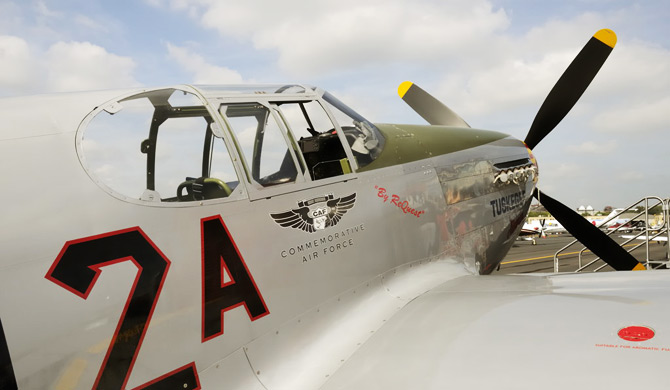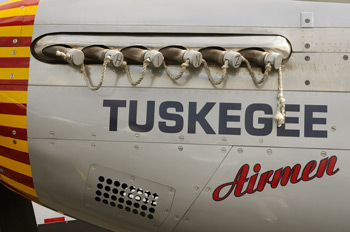The Tuskegee Airmen—black airmen who trained as pilots in Tuskegee, Ala., during World War II as an “experiment” because the military didn’t believe they could learn to fly and fight—proved themselves in combat as the military’s first black pilots. Shortly after the war, they were largely responsible for desegregation of the Air Force, the first branch of the military to desegregate.

Their contributions were recalled at AOPA Aviation Summit on Sept. 22 by Oscar Award-winning actor Cuba Gooding Jr., one of the stars of Red Tails , a new film by George Lucas set for release in January that tells how the Tuskegee Airmen continued to overcome adversity to prove themselves heroically in combat. And a new traveling exhibit operated by the Commemorative Air Force’s Red Tail Squadron, Rise Above, is on display at Airportfest at Hartford-Brainard Airport through Sept. 24. The centerpiece of the exhibit is a restored P-51C Mustang, painted in the distinctive red tail paint scheme the Tuskegee Airmen acquired in Europe—but the exhibit is really about the multimedia presentation shown in the portable panoramic theater.
 Gooding, who is not a pilot but said he’s spent a lot of time in simulators and around pilots, was interviewed by AOPA President Craig Fuller on AOPA Live.
Gooding, who is not a pilot but said he’s spent a lot of time in simulators and around pilots, was interviewed by AOPA President Craig Fuller on AOPA Live.
“The closest I came to actually controlling in flight was a movie I did called Outbreak,” said Gooding, who performed several helicopter takeoffs—but not the landings, he quickly added. “I’d never trained to be a pilot but I’ve been behind the stick of a few Cessnas.”
Gooding starred in a 1995 film, The Tuskegee Airmen. When the move Red Tails was announced, agents said they didn’t want to use any actors from the original movie. But the Tuskegee story appealed so much to Gooding that he mounted a campaign, and was able to sit down with the director. It turns out that the director had him in mind for the role he landed in the film. “The first one was a $2 million HBO film. This one was George Lucas’ passion project,” he explained. “It’s a nice bookend piece for the original Tuskegee movie, where I was a pilot.” In this film, Gooding’s character—Maj. Emanuelle Stance—is in an instructional role.
“I always am excited when there’s a role in development about a real-life character,” he added, explaining that it heightens his desire as an actor to get the depiction right—especially if the person is still alive. “You get to embody a sense of who that person is and present that to the world. That’s always really exciting to an actor. One of my goals as an actor is to continue to do that. It’s always enriching and rewarding.”
The veteran actor has not yet seen the film, which is still in post-production. “From the materials I’ve seen, I’m very proud of the accomplishments…the emotional impact that I’ve seen it have on me. [The film] really conveys the tribulations they went through in combat.”
Gooding shared a little inside information, as well: Look for the release of Double Victory ahead of the movie. “Lucas put together a two-hour documentary on the history of the Tuskegee Airmen.”
Several of the original Tuskegee Airmen were on the set every day in Prague, in the Czech Republic, where Gooding filmed for 13 weeks. “They would sit and talk about stories and it would remind them of something…they would tell us more. They were checking our uniforms and moving our belts. If there was anything too heightened in reality they would pipe up,” he said. “There’s a connection,” Gooding said, explaining that he’s called to stories themed around the African-American experience. “Those stories to me are very attractive—they’re very telling.”
 At Airportfest, look behind the immaculately restored Mustang to see the Rise Above portable theater. Inside, a 13-minute panoramic multimedia presentation with surround sound tells the story of the Tuskegee Airmen. (A longer, 35-minute program tells a more detailed story to student groups.)
At Airportfest, look behind the immaculately restored Mustang to see the Rise Above portable theater. Inside, a 13-minute panoramic multimedia presentation with surround sound tells the story of the Tuskegee Airmen. (A longer, 35-minute program tells a more detailed story to student groups.)
The airplane was restored in 2001 and flown to honor the Tuskegee Airmen, explained Doug Rozendaal, one of the Mustang’s pilots. It was damaged during a landing accident after the engine failed in 2004, and pilot Don Hinz was killed. At the time, the squadron had no money and wasn’t sure what to do. “We used the Tuskegee Airmen as an example of what to do,” he said. “We pulled it together and then we just kept going. Don’s vision was to use [the airplane] for education.”
That led to the portable theater and a traveling exhibit. The Texas Flying Legends, a museum at Ellington Field in Houston, saw what the squadron was trying to do and was so impressed by the Tuskegee Airmen that they provided the funding for the Rise Above exhibition.
The trailer is an immersive experience, Rozendaal said. “You’ve got to create an experience in order to change behavior,” he said, paraphrasing FAA flight instructor training materials. “Our sense is that we’ve created an experience.” Some of the multimedia content is from Red Tail Reborn, a documentary that features the Mustang’s second restoration, following the crash.
The Rise Above exhibit debuted at EAA AirVenture in Oshkosh in July and has only been on the road for 45 days, Rozendaal said. The squadron plans to display the exhibit two or three times each week, often taking it off-airport. “We’re planning a 40-week tour for next year, over nine months,” he explained. “We’ll take it to wherever the kids are.”
While they seek to take the story to young people—and ideally bring kids out to the airport—the primary goal is to tell the story of the Tuskegee Airmen. “At the end of the day, it’s about the kids drawing a target on the wall for what they want to be when they grow up,” Rozendaal said. “We all have overcome adversity. And these guys showed the world it could be done.”
For more information on the Red Tail Squadron’s Rise Above exhibit, for schedule information when it becomes available, or to support the tour, see the website.


